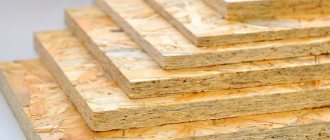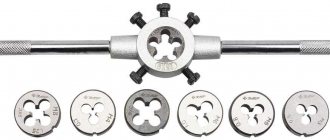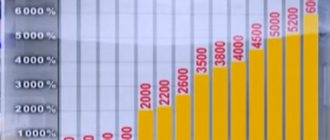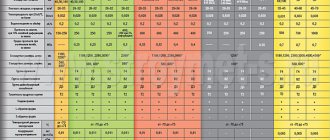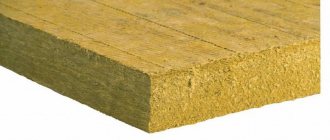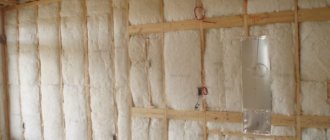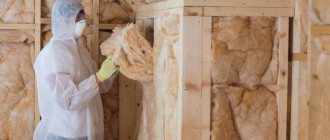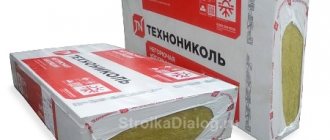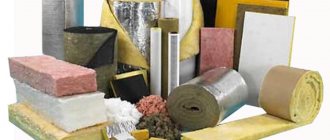How to transport insulation correctly
Mineral insulation has a fibrous structure, the violation of which leads to a decrease in thermal insulation properties.
This makes it ineffective to use scissors for thick fabrics or cardboard, as well as table or stationery knives for cutting it. Therefore, the answer to the question of how to cut mineral wool correctly without disturbing its structure will be useful for beginning builders. To separate webs and rolls, professionals use a special machine. But many people ask the question: “What is the best way to cut mineral wool into slabs at home to save money?”
In everyday life, a mounting knife is used to cut the canvas. This tool has one drawback: due to the small blade, it is difficult for them to cut thick slabs. Therefore, I recommend using a stationery knife only for thin sheets. If this condition is not observed, the canvas may become unusable.
Cutting mineral wool with a knife
Tools best suited for cutting mineral insulation:
- A knife whose blade is made of carbon steel. This product is very easy to cut, in addition, its blade sharpens well and quickly. This knife requires careful care to avoid rust. The basic rule of care is to wipe the blade after washing.
- A knife whose blade is made of stainless steel. Each side has teeth of different lengths, so it is very easy to cut mineral insulation of different sizes and thicknesses. The blade quickly sinks into the slab and cuts it efficiently. The sharp tip can even make indirect cuts.
- Special machines. Such tools are capable of cutting fabrics along a straight line and along a bend. This feature is highly valued in industry. If you need to cut the cotton wool once, then there is no point in purchasing expensive equipment - the tool that you have in the house will do.
Cutting mineral wool with a special saw
To cut wool, it is advisable to use a special hacksaw for insulation or metal. It is used for cutting material whose thickness does not exceed 5 cm.
The blades of the tool you use to cut wool should always be well sharpened. In this case, the fibers from the cotton wool will be pulled out minimally. Manufacturers advise cutting the cotton wool before unrolling the roll.
Today, manufacturers offer a sufficient number of insulation materials. Each of these materials is used in certain conditions and has its own price. However, the most popular are insulation materials that provide optimal heat retention and have a long service life. The second no less important point is the cost, which should be acceptable.
Scheme of insulation of the roofing pie system.
Scheme of basalt insulation.
- thermal insulation and hydrophobization. The first parameter is from 0.042 to 0.048 W/mK. Other well-known insulation materials (for example, polystyrene foam, polyurethane foam) have approximately the same characteristics. Mineral wool is not able to accumulate moisture (hygroscopicity is less than 1%), which makes its weight unchanged. A distinctive feature is vapor permeability, which guarantees insulation and at the same time intense moisture exchange between the external environment and the walls of the building;
- density, strength. The insulation has sufficient density (from 30 to 100 kg/cubic m), which guarantees high thermal insulation properties with optimal strength. The rigidity of the material is ensured by the direction of the fibers; they are located in horizontal and vertical directions;
- soundproofing. Good noise protection characteristics are achieved due to the porous structure of the wool;
- resistance to aggressive environments. Vata is “indifferent” to alkali and acids; does not rot, is not affected by fungus. Rodents also avoid this insulation;
- fire resistance. Basalt wool can withstand heating up to 700°C. This protects the structure from complete destruction in a fire and gives time for residents to evacuate;
- health safety. In production, resins containing harmful substances (formaldehyde, phenol) are used. However, adherence to the technology requires their introduction into the insulation composition in a chemically bound state. The substances become completely neutral in relation to the environment and do not pose a danger to humans.
The manufacturer produces the material in the form of rolls or slabs. Mineral wool insulation is used for walls, roofing or interior partitions. In the latter case, mainly to achieve good soundproofing parameters of the structure. During installation, the requirements for insulation are taken into account, which you need to know before purchasing:
- installation in a sloping roof involves the use of wool with a density of at least 30-40 kg/cu. m, otherwise the material will simply sag over time. Recommended thickness - 15 cm;
- the arrangement of partitions should be carried out using mineral wool with a density of 50 kg/cubic. m. Increased density is needed to ensure high-quality noise insulation;
- Load-bearing walls are best insulated from the outside, because this will bring the dew point, where condensation will form, to the outside of the wall. The density of the material must be at least 80 kg / cubic meter. m, and thickness - 10 cm.
Modern mineral wool is a high-quality insulation material that has been tested for decades. Current technologies have made this material completely safe for installation and operation, and its technical characteristics, combined with cost, leave its closest competitors behind.
The science is simple, but very important. So:
- slabs and mats are transported horizontally;
- the truck must have a protective awning;
- transportation is carried out only in packaged form;
- during transportation, loading and unloading operations, it is important not to compress the insulation too much;
- unpack the mineral wool immediately before starting insulation work.
On an industrial scale, special machine equipment is used to cut mineral insulation. Let's consider how to cut mineral wool insulation yourself at home.
Often a mounting knife is used to cut mineral wool. But it has one drawback - a short blade, which is not suitable for working with thick insulation boards. In addition, the blade quickly becomes dull and requires replacement.
Sometimes a special hacksaw is used for wood or metal, and folk craftsmen have found a way to cut mineral wool at home - a kitchen serrated knife for cutting bread.
But still, when choosing how to cut stone, glass or slag wool, it is better to use special tools.
A knife for cutting insulation with a long blade made of durable stainless steel is suitable for working with mineral wool of any thickness. To cut insulation of different hardness, larger and smaller teeth are located on each side. This blade easily penetrates the thickness of the slab, allowing you to make even shaped cuts thanks to its sharp tip.
We invite you to familiarize yourself with Building from profiled timber with your own hands
The mineral wool cutting knife with a carbon steel blade has high cutting quality and is easy to sharpen. However, it requires more careful care compared to a stainless steel blade, as it is susceptible to rust. It must be wiped dry after each use and lubricated.
The Swedish company MORA produces tools for cutting mineral insulation. A knife with a stainless steel blade is used for cutting stone and glass mineral wool. The blade is made of special cold-rolled stainless steel and has a serrated sharpening. The ergonomic and comfortable plastic handle is suitable for working with gloves. Its characteristics:
- total length - 500 mm;
- blade length - 335 mm;
- blade thickness - 1 mm;
- weight - 0.238 kg.
A knife with a carbon steel blade is used for cutting different types of mineral insulation. It has a smooth blade made of high-quality carbon steel with a length of 350 mm. The plastic handle provides a good grip when wearing work gloves.
Features of installing mineral wool insulation
The manufacturer produces the material in the form of rolls or slabs. Mineral wool insulation is used for walls, roofing or interior partitions. In the latter case, mainly to achieve good soundproofing parameters of the structure. During installation, the requirements for insulation are taken into account, which you need to know before purchasing:
- installation in a sloping roof involves the use of wool with a density of at least 30-40 kg/cu. m, otherwise the material will simply sag over time. Recommended thickness - 15 cm;
- the arrangement of partitions should be carried out using mineral wool with a density of 50 kg/cubic. m. Increased density is needed to ensure high-quality noise insulation;
- Load-bearing walls are best insulated from the outside, because this will bring the dew point, where condensation will form, to the outside of the wall. The density of the material must be at least 80 kg / cubic meter. m, and thickness - 10 cm.
Cutting mineral wool, how and how to cut mineral wool in rolls and slabs
Mineral wool is an artificial building material that is made for heat and sound insulation of residential buildings and industrial premises. The material is not afraid of fire, resistant to various weather conditions. For convenience, they are produced in rolls and mats. It is not enough to purchase insulation; it is also important to know how to work with it; this will be discussed below.
Insulating the attic space is an effective way to reduce heat loss; as a result, the house needs to be heated less, which means you can save on electricity.
Mineral wool insulation is a versatile, high-performance option for thermal and acoustic performance, as well as fire resistance.
The insulation consists of fibers.
When working with material, a large number of harmful particles are released into the air. Fine dust is hazardous to human breathing and skin. Therefore, precautions are taken when working with it.
What rules must be followed:
- work in a well-ventilated area.
- For work, personal protective equipment is used: mask, goggles, respirator.
- They work in special clothing: well-buttoned overalls, a hat, and construction gloves.
- After work, wash your hands and face thoroughly under cold water. The overalls are shaken out of dust.
To insulate a house with mineral wool, it is cut and the material is cut lengthwise and crosswise. Each type of cut has its own rules, following which the work will be much easier to do.
Mineral wool in rolls is cut unpacked. The roll is placed on a hard, flat surface. Use a tape measure to measure the required length. Place marks in three places around the package. For accuracy, the cutting area is wrapped with masking tape.
Then take a saw and cut a roll of mineral wool in a circle. After the cut piece has been separated, remove the packaging film.
Important. Masking tape is wound onto the roll on the opposite side of the workpiece so that after cutting the remaining part of the roll does not unwind.
For cross-cutting, the mineral wool roll is unpacked. Make markings on both sides. Then apply a flat bar: a ruler, a piece of profile or a beam.
A knife or hacksaw is used along the plank. If it is not possible to cut off the insulation in one movement, the cut is repeated several times. The material is cut to the end so that it does not have to be torn off, in which case the geometry will be disrupted. You'll have to level the insulation.
Important. When cutting the insulation, put a board under it so that the knife does not become dull.
In production, the material is cut on machines using special circular saws. At home, you can cut the insulation using a utility knife, a wood saw and special knives for insulation.
Tools:
- A stationery knife is used only for transverse cuts, since its blade size is not large. The cutting part quickly becomes dull, which is why the blade is often changed. A stationery knife is used to cut a small amount of insulation.
- To cut the mineral wool along the roll, use a wood saw. A hacksaw has a long blade that cuts through a roll. The disadvantage is that after such a cut there remains a lot of waste from the insulation. When carving, the teeth of the hacksaw tear out pieces of insulation.
- A bread knife with a long blade 200 - 300 mm is a convenient tool for cutting insulation along and across a roll. The serrated blade easily cuts insulation fibers without leaving much waste. The disadvantage of a kitchen knife is that it quickly becomes dull. If there is a lot of work, the knife will have to be sharpened periodically to ensure an even cut.
- Special knives are made for professional cutting of mineral wool. The length of the tool with handle is 500 mm, the length of the blade is 330 mm. The knives are made of stainless and cold-rolled steel; the special wavy-toothed sharpening of the tool allows for smooth cutting of the material.
Choosing the right tool for the job and following the recommendations will help make home insulation an enjoyable and useful task that will not bring unnecessary hassle.
A distinctive feature of mineral insulation is its structure consisting of fibers, which must be solid to ensure thermal insulation. In this regard, special attention should be paid to the cutting process. Do not use cardboard or fabric scissors, or ordinary table knives to cut the material.
What will we cut with?
On an industrial scale, special machine equipment is used to cut mineral insulation. Let's consider how to cut mineral wool insulation yourself at home.
Often a mounting knife is used to cut mineral wool. But it has one drawback - a short blade, which is not suitable for working with thick insulation boards. In addition, the blade quickly becomes dull and requires replacement.
Sometimes a special hacksaw is used for wood or metal, and folk craftsmen have found a way to cut mineral wool at home - a kitchen serrated knife for cutting bread.
Knife with stainless steel blade
A knife for cutting insulation with a long blade made of durable stainless steel is suitable for working with mineral wool of any thickness . To cut insulation of different hardness, larger and smaller teeth are located on each side. This blade easily penetrates the thickness of the slab, allowing you to make even shaped cuts thanks to its sharp tip.
Knife with carbon steel blade
The mineral wool cutting knife with a carbon steel blade has high cutting quality and is easy to sharpen . However, it requires more careful care compared to a stainless steel blade, as it is susceptible to rust. It must be wiped dry after each use and lubricated.
For example: MORA knife for cutting mineral wool
The Swedish company MORA produces tools for cutting mineral insulation. A knife with a stainless steel blade is used for cutting stone and glass mineral wool . The blade is made of special cold-rolled stainless steel and has a serrated sharpening. The ergonomic and comfortable plastic handle is suitable for working with gloves. Its characteristics:
- total length - 500 mm;
- blade length - 335 mm;
- blade thickness - 1 mm;
- weight - 0.238 kg.
A knife with a carbon steel blade is used for cutting different types of mineral insulation. It has a smooth blade made of high-quality carbon steel with a length of 350 mm. The plastic handle provides a good grip when wearing work gloves.
What are leftover mineral wool useful for?
If there are scraps left after working with mineral wool, you can use them to insulate, for example, a garage or shed. Some people choose this budget option for insulation, so they can sell the leftovers at a low price.
There is also the option of recycling waste for recycling. In this case, the remains of mineral wool slabs are crushed using special equipment.
There is no need to throw away the remaining insulation: they will also be useful for the pantry or utility room. Many people strive for budget insulation, so they use scraps and leftover material.
Waste mineral wool can be recycled for later use. In this case, special machines are used.
In order for the process of insulating a room to proceed properly, you should know what you need to use to cut mineral wool and how to do it. If you follow simple rules for working with this insulation, you can achieve good results.
We suggest you familiarize yourself with How to cover up a crack in a cast iron stove
Safe working conditions
When working with glass wool, it is necessary to wear protective clothing.
The main component of mineral wool is thin and sharp fibers. During operation, they break away from the base and rise into the air. Contact of these particles on the body causes burning of the skin, pain in the eyes and irritation of the respiratory mucosa.
To prevent harm to your own health, it is necessary to create the following working conditions:
- preventing accidental entry of strangers into the place of work;
- removing people and animals to a safe place if cutting is done outdoors;
- use of overalls, masks, respirators, sealed goggles and rubberized gloves;
- high-quality ventilation in the room, preventing the entry of volatile substances into neighboring rooms;
- cutting across the grain to reduce the amount of volatile compounds;
- wet cleaning with preliminary cleaning of surfaces with a vacuum cleaner;
- covering the insulation with plaster, vapor-permeable or windproof film for complete insulation.
After finishing cutting and installation, you need to take a shower, preferably under cool water, so that the fibers come off the skin and hair more easily.
Cutting mineral wool, how and how to cut mineral wool in rolls and slabs
There are always a lot of questions about what and how to cut mineral wool. Especially for those who are going to build housing on their own (for example, frame housing, which involves assembling it yourself). After all, in its structure it is a fibrous material, which also has a certain thickness. Ordinary table knives or scissors designed for cutting cardboard or thick fabrics are completely unsuitable here.
However, before you start cutting mineral wool, it is important to deliver it correctly to the construction site. Indeed, otherwise, the material, brought to the state of defect, will not have to be cut, but simply replaced with a new one. And these are additional costs.
A characteristic feature of mineral insulation material is that it consists of fibers, which must be solid to provide thermal insulation. Therefore, great attention should be paid to the cutting process.
Do not use cardboard or fabric scissors, or ordinary table knives to cut the material. These tools are not intended for such material, because they can spoil its appearance and impair its good properties.
It is very useful for novice repairmen and builders to find out what tools are suitable for this job.
At the beginning of construction or renovation work, the owner of the premises thinks about what parameters should be used to select materials. Now the choice of sale flashes across different canvases, differing from one to another in raw materials, price, area of use, and operating properties.
Glass fiber wool (glass fiber) is distinguished by its low density and high hygroscopicity.
The material does not have water resistance parameters, and heat resistance should not be expected from it: when a high heating temperature is reached (about 300 degrees), the wool fibers melt, and the material no longer performs the function of insulation. Fiberglass-based wool is sold in rolls.
Fiberglass-based wool is made by blowing: an industrial centrifuge produces air currents that go directly into the raw material. Due to the air flow, fibers appear from the threads, and they can have very different lengths, tendencies and thicknesses.
Mineral wool has low heat conductivity, allows steam to pass through due to the cells in its structure, and practically does not absorb water.
In addition to the base, there are few binding components in the composition, which allows it to withstand high temperatures.
The material is widely used as sound insulation and insulation material for various substrates and surfaces. It is made using canvases that vary in strength.
Slag wool for thermal insulation of premises
Slag wool is considered the most inexpensive option for thermal insulation.
The material consists of fibers that are waste from blast furnaces; it is not dense and does not have good heat resistance. If you overheat slag wool, it will sinter.
The structure of a horizontal layer of any type min. wool is created in the direction of the fiber. The formation of vertical sections occurs due to components that are located randomly. Each material has its own characteristics and external differences.
Manufacturers advise storing mineral wool in its entire packaging, and it is ideal if the pack is placed on a smooth surface. Each stack of packages should not be more than 2 meters.
Ideal storage conditions are closed premises that are resistant to moisture penetration.
It is not recommended to store the heat insulator outside, however, if this happens, then it is necessary to cover it with a tarpaulin or film.
It is necessary to store the cotton only horizontally
When transporting, you should follow similar rules: transport cotton wool in a horizontal position and in a dry truck bed. It is also necessary to provide the material with protection from mechanical influences and hydrometeors. When loading and unloading material, do not compress it too much.
Unpacking mineral material for insulation also requires some nuances.
The material should be removed from the packaging only at the beginning of work, which will make it possible to minimize various risks associated with damage to the insulation material.
When laying out the material for cutting, use its packaging as a bedding. Likewise, the product will not become dirty. Also, the packaging can be used to collect other waste at a construction site.
To divide webs and rolls, specialists use a specialized machine. But most people ask themselves: “What is the best way to cut mineral wool in slabs at home to save money?”
Important! To cut mineral wool, use a hacksaw for metal or wood.
For everyday tasks and purposes, a knife for installation work is used to cut the canvas. This tool has the only drawback: due to the small blade, it is difficult for them to cut thick slabs. Therefore, I recommend using a stationery knife exclusively for thin sheets. If this condition is not met, the canvases may fail.
Cutting mineral wool with a knife
Tools that are much better suited for cutting mineral insulation material:
- A knife whose blade is made of carbon steel. This product is quite easy to cut, and its blade sharpens well and quickly. This knife requires careful care to avoid rust. An important rule of care is to wipe the blade after washing.
- A knife whose blade is made of stainless steel.
On either side, teeth of different lengths are taken into account, making it quite easy to cut mineral material for insulation of various sizes and thicknesses. The blade quickly sinks into the slab and cuts it efficiently. The sharp tip can even make indirect cuts. - Special machines.
Such tools are capable of cutting fabrics along a straight line and along a bend. A similar feature is highly valued in industry. If you need to cut cotton wool just once, then there is no point in buying expensive equipment - the tool that you have in the house will do.
Cutting min. cotton wool with a specialized saw
Worth paying attention! Scissors cannot be used for cutting cotton wool.
To cut wool, it is best to use a specialized hacksaw for heat insulators or for metal. It is used to cut material whose thickness does not exceed 5 cm.
The blades of the tool you use to cut cotton wool must always be perfectly sharpened. In this option, the fibers from the cotton wool will be pulled out minimally. Manufacturers recommend cutting the cotton wool before unrolling the roll.
The material is distinguished by its fibrous structure, due to which very small particles of glass wool fly in space during cutting. In this regard, it is necessary to prevent the penetration of hazardous components onto the skin and into the respiratory tract.
We suggest you familiarize yourself with Sand between floor joists
Before cutting the heat insulator, the following conditions must be met:
- The room should be well ventilated.
- During work, the use of protective equipment and specialized clothing is mandatory. We are talking about gloves, a respirator, a mask, a suit and goggles for protection.
- When the material is cut, it is recommended to wash your face and hands under cold water.
To ensure that as few glass wool particles as possible appear in the air, it is necessary to use a high-quality sharpened tool.
The insulation should be cut without unrolling the roll.
Advice! It is much better to cut the material crosswise.
In order to obtain strips of cotton wool equal in width, you should cut the material directly in the roll. If the wool is in the form of slabs, then you need to cut them one by one.
In order for the strips of cotton wool, separated by your own efforts in domestic conditions, to turn out ideal and similar, they should be separated clearly by marks. You can also use a ruler as a cutting line.
When cutting, leave allowances along the edges. If it is a roll, then the indicator must be 0.5 cm, and if it is a slab, then 2 cm. This cutting characteristic is necessary so that the mineral wool component completely fills the required space.
Please note that the slabs min. The cotton wool is cut one at a time, and the material in the roll is cut without unrolling.
There is no need to throw away the remains of the insulation material: they will also be useful for the pantry or utility room. Many people want budget insulation, so they use scraps and leftover material.
Waste min. wool can be recycled for future use. In this option, specialized machines are used.
In order for the insulation process of the room to proceed properly, you need to know how to cut the mineral wool and how to do it. If you follow the usual rules for working with this heat insulator, you can achieve excellent results.
Characteristics and properties of the material
Before starting construction or renovation work, the owner of the premises thinks about what criteria should be used to select materials. Currently, the sales range is replete with a variety of canvases that differ from each other in raw materials, price, scope of application, and operating characteristics.
Glass wool (made from fiberglass) is characterized by low density and high hygroscopicity. The material does not have moisture resistance properties, and heat resistance should not be expected from it: when a high heating temperature is reached (about 300 degrees), the wool fibers melt, and the material no longer serves as an insulator. Glass wool is sold in rolls.
Glass wool is produced using the blow molding method: an industrial centrifuge creates air flows that go directly into the raw material. Due to the flow of air, fibers appear from the threads, and they can have different lengths, directions and thicknesses.
Mineral wool has low thermal conductivity, allows steam to pass through due to the cells in its structure, and almost does not absorb water. In addition to the base, there are few binding elements in the composition, which allows it to withstand high temperatures. The material is widely used as sound insulation and insulation for various substrates and surfaces. It is produced in sheets that vary in strength.
Slag wool for room insulation
Slag wool is the cheapest option for insulation. The material consists of fibers that are waste from blast furnaces; it is not dense and does not have good heat resistance. If you overheat slag wool, it will sinter. Therefore, the material is not suitable for insulating rooms adjacent to heat sources, and is also not recommended for building houses.
The structure of the horizontal layer of any type of mineral wool is created in the direction of the fiber. The formation of vertical sections occurs due to elements that are located chaotically. Each type of material has its own characteristics and external differences.
Are there any nuances in transportation and storage?
Manufacturers recommend storing mineral wool in intact packaging, and it is better if the pack is placed on a flat surface. Each stack of packages should not be higher than 2 meters. Optimal storage conditions are closed rooms that are resistant to moisture. It is not recommended to store insulation outside, but if this happens, then you need to cover it with a tarpaulin or film.
Cotton wool should only be stored horizontally
When transporting, you should follow the same rules: transport the cotton wool horizontally and in a dry truck bed. It is also necessary to provide the material with protection from mechanical influences and precipitation. When loading and unloading material, do not compress it too much.
Unpacking mineral insulation also requires certain nuances. The material should be removed from the packaging only before starting work, which will minimize various risks associated with damage to the insulation. When laying out the material for cutting, use its packaging as a bedding. Thus, the product will not get dirty. Also, the packaging can be used to collect other waste at a construction site.
Proper transportation of material
Storage and transportation of mineral wool is carried out in even stacks so as not to damage the material
Since the material is porous, brittle and hygroscopic, it must be handled accordingly.
When transporting and storing mineral wool, it is recommended to observe the following rules:
- During the loading and unloading process, do not throw the packages, but carefully place them, avoiding their falling and strong compression.
- Transport bales in covered trucks, placing them horizontally on a level bottom. Fix the insulation so that it does not hit the body walls.
- Store products in dry, closed areas. If this is not possible and it is stored outside, cover it with film or tarpaulin to protect it from precipitation.
- Remove slabs from the stack immediately before laying them. This will prevent moisture absorption and reduce the risk of accidental damage to the material.
